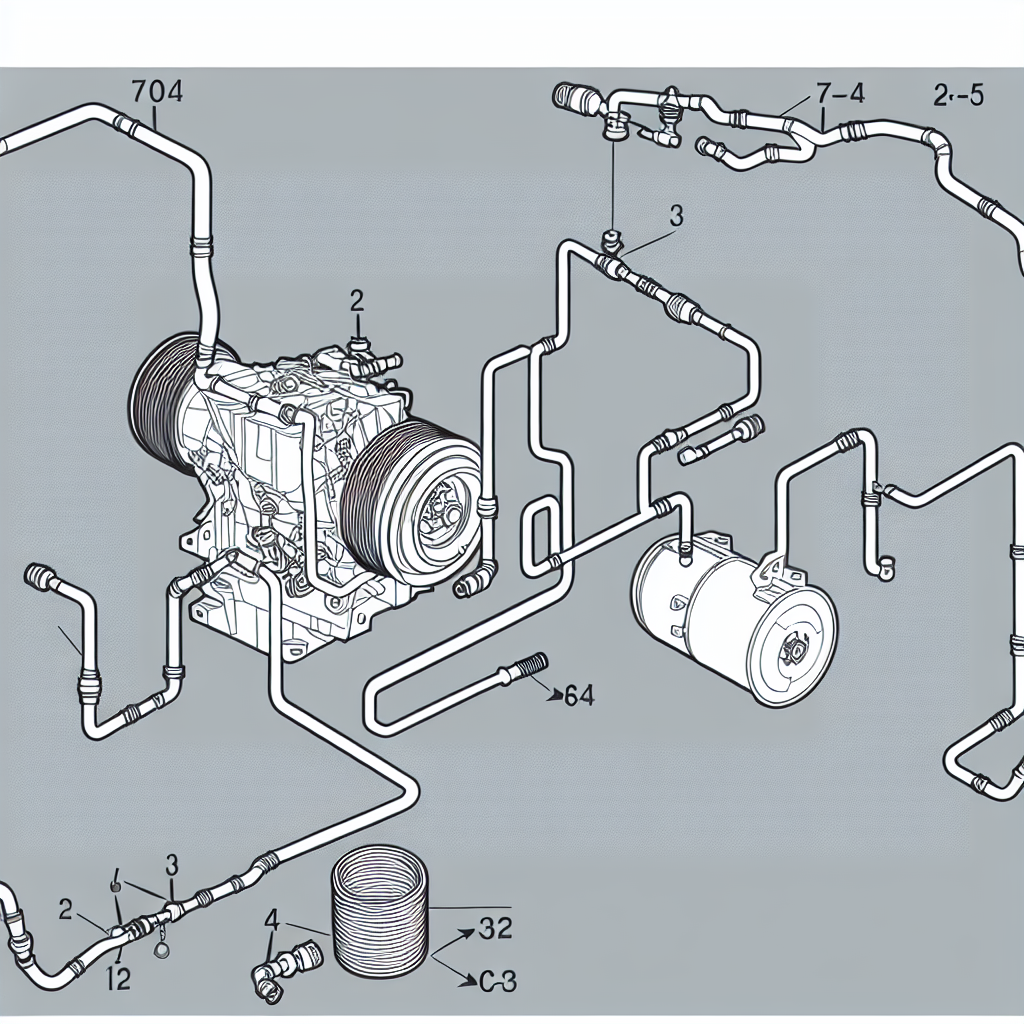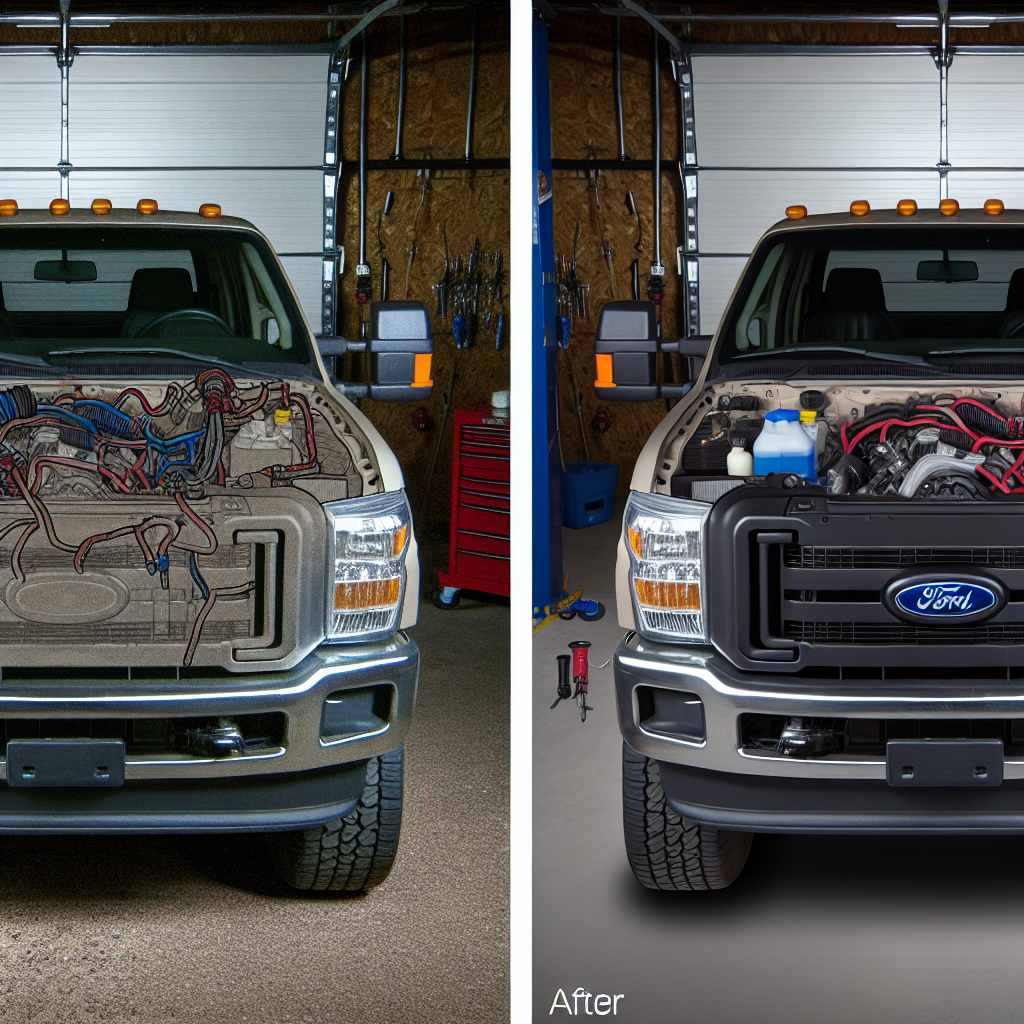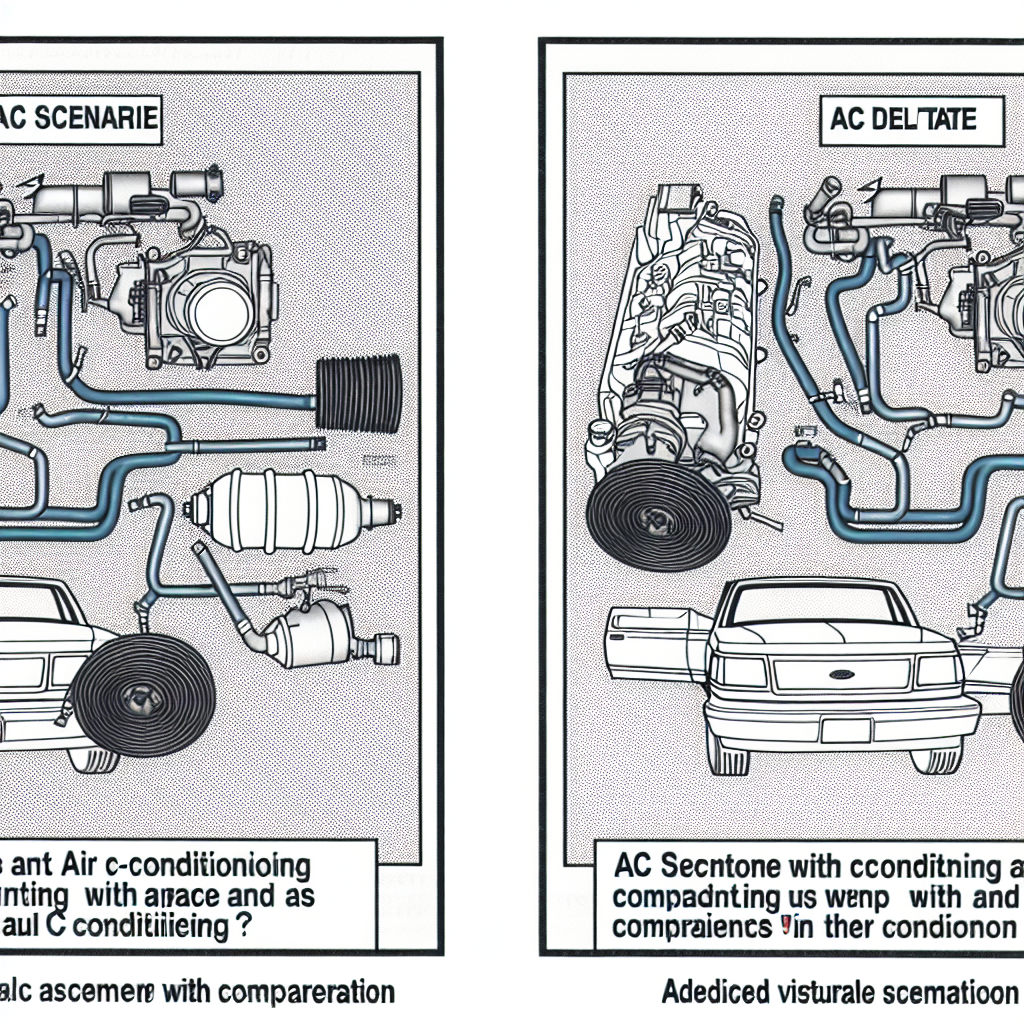Removing the air conditioning (AC) from a classic 1989 Ford F250 might seem like a straightforward decision for some truck owners, but is it really that simple? As time takes its toll on these vintage vehicles, many enthusiasts find themselves questioning the practicality and implications of such a modification.
With factory AC components that have not worked for years, cracked hoses, and a system that could potentially drain resources, the idea of an AC delete raises several intriguing considerations. Would removing the AC truly streamline maintenance, or could it inadvertently lead to complications down the road? How might it affect the truck’s performance, especially when factoring in the belt system?
The discussion about AC removal is not just about comfort; it’s about understanding the full scope of what this decision entails for an older truck like the F250. With age comes wear and tear – is stripping down this system a practical solution, or an oversight waiting to happen?
Current State of the AC System in the 1989 Ford F250
The air conditioning system in the 1989 Ford F250 is now a relic of its factory design. Unfortunately, it has been non-functional for years. Many owners report that their AC units do not work, leaving them with a system that is not just ineffective but possibly problematic. Typically, the decline of the system starts with the hoses. In this instance, several hoses are cracked, which can lead to refrigerant leaks and further issues if repair attempts are made.
Furthermore, the system’s age plays a critical role. The technology in factory-installed AC systems from the late 80s often does not meet today’s standards, prompting many enthusiasts to think about removing the AC completely.
A properly functioning AC system is more than just a luxury—especially in a work truck. It can enhance the comfort of the driver and passengers, reduce fatigue during long trips, and even contribute to the vehicle’s longevity through regulated temperatures. However, with an aging system, it’s essential for owners to consider the consequences of keeping it versus removing it.
As the discussion turns to AC removal, it’s crucial to address the potential impacts of this action on the vehicle’s overall functionality. For instance, will leaving components like the compressor in place but without power affect the belt system? These questions highlight the complexities of modifying an older vehicle and stress the importance of thoroughly understanding the existing issues before proceeding with any changes. The following sections will explore specific steps and considerations for AC removal in the F250, helping owners make informed choices moving forward.
| Pros of Keeping AC | Cons of Keeping AC |
|---|---|
| Provides comfort during hot weather | Increases weight and complexity of system |
| Potential resale value enhancement | Maintenance issues may arise from aged components |
| Essential for some drivers’ comfort | Inefficient compared to modern systems |
| Reserves original factory specifications | Heating issues may arise if refrigerant leaks occur |
| Pros of Removing AC | Cons of Removing AC |
|---|---|
| Reduces weight, potentially improving performance | Possible negative impact on resale value |
| Less maintenance required on an unused system | Leaving components (like the compressor) could affect engine efficiency |
| Simplifies engine bay layout | May reduce cabin comfort for occupants |
| Can save on repair costs associated with aging parts | Some drivers may regret removing it during hot weather |
Insights from Community Discussions on AC Removal
Analyzing user quotes from discussions on AC removal in older Ford trucks reveals a wealth of insights into community perspectives. Owners frequently express varied concerns about the practicality and consequences of modifying their vehicles. Common questions emerge, such as whether one can remove hoses but leave the compressor in place for the sake of belt integrity. This uncertainty underscores a general hesitation among truck enthusiasts when faced with potential complications concerning vintage vehicle modifications. Balancing comfort, performance, and the preservation of factory specifications remains a key dilemma for these owners.
When diving into forum discussions, a post by GREASE FIRE on Oilburners.net from 2008 reflects a specific concern: a previous owner had removed the entire AC idler pulley unit from his 1989 F250, complicating the reinstallation of the AC belt. This example illustrates the complications that can arise when components are removed without proper documentation or awareness of how it affects the vehicle’s functionality. In another thread from 2017, a user detailed their experience rebuilding the AC system of a 1986 model, which involved fabricating custom brackets and switching to a different compressor model. Such experiences showcase the technical challenges that accompany altering or completely removing AC systems from older trucks.
Additionally, a 2019 discussion focused on overhauling the AC system entirely by replacing components and adapting them for modern refrigerants like R134a, emphasizing the complexities and planning necessary for successful modifications. Recommendations from veterans of these discussions highlight the significance of preserving original components and consulting experienced mechanics. Many users emphasize the need for assessing how the removal might impact belt routing and engine performance, discouraging hasty decisions without thorough understanding.
Furthermore, insights from authoritative sources provide further context on maintaining AC components in older vehicles. According to the Motorist Assurance Program, it’s vital to perform regular inspections of the AC system, such as checking refrigerant levels and replacing cabin air filters (motorist.org). Tips from Happy Wallet Quality Auto Repair guide owners to keep the condenser clean and monitor refrigerant levels for optimal performance (happywalletautorepair.com). Additionally, Hialeah Auto Care Center stresses running the AC regularly to ensure proper lubrication of the compressor (hialeahautocare.com).
Overall, these community insights reveal a nuanced balance of concerns and careful considerations that owners of older Ford trucks take into account when contemplating AC removal. The discussion is not just about comfort; it touches on preserving the vehicle’s integrity, performance, and the intricacies of automotive repair.

Alternative Solutions for Cooling in Older Vehicles
For those contemplating the removal of the AC system in older vehicles, particularly vintage trucks like the 1989 Ford F250, there are several alternative solutions available to enhance comfort without the need for air conditioning. Below, we explore practical options that are not only efficient but can also be implemented with relative ease.
1. Installing Auxiliary Fans
Adding auxiliary fans can significantly improve air circulation within the cabin, making the driving experience more pleasant on hot days.
- Types of Fans: You can choose between 12V electric fans, which are easy to install and can be run directly from the vehicle’s electrical system, or mechanical fans that attach to the engine.
- Installation Tips:
- Mounting Location: Install the fan in the front of the radiator or even within the engine bay, focusing on areas where airflow is limited.
- Wiring: Ensure the fan is wired to operate automatically with the ignition or use a switch inside the cabin for manual control.
2. Window Tinting
Window tinting is another effective method to reduce interior heat buildup, protecting passengers from harmful UV rays and keeping the cabin cooler.
- Benefits: Tinted windows can reject a significant amount of solar energy, leading to cooler temperatures inside the vehicle.
- Installation Tips:
- Choosing Tint: Select a tint that balances visibility and heat rejection; darker tints may offer better heat protection but can decrease visibility in low light.
- Applying Tint: For a professional finish, consider hiring a specialist, but if attempting a DIY, ensure the windows are cleaned thoroughly and use a squeegee to avoid bubbles during application.
3. Ventilation Management
Optimizing ventilation can help reduce reliance on air conditioning.
- Open Windows: On the highway or during cooler hours, simply opening windows can allow a refreshing breeze.
- Wind Deflectors: Consider installing deflectors that let you keep windows cracked during rain or at high speeds, promoting airflow while protecting against the elements.
4. Reflective Sun Shades
Using sun shades or reflective coverings during hot weather can prevent the sun from heating up your interior and dashboard.
- Types: Custom-fit shades for the windshield, side windows, and rear window can significantly reduce heat buildup inside the cabin.
- Installation: These shades typically do not require permanent installation and can be placed or removed easily.
5. Regular Maintenance of Existing Ventilation
Lastly, keeping the ventilation system in good working condition is vital.
- Duct Cleaning: Ensure that air ducts are clean and free from obstructions to maximize airflow.
- Fan Motor Checks: Regularly inspect and service the interior blower fan to ensure it operates efficiently.
In conclusion, while removing the AC system from an older vehicle might seem advantageous to some, these alternative solutions can help maintain or even enhance overall vehicle comfort without sacrificing functionality. By considering these practical options, truck owners can enjoy a more pleasant driving experience during warm weather, ensuring their vintage vehicles remain enjoyable on the road.
Keywords Added: ‘air conditioning alternatives’, ‘Ford F250 modifications’
User Adoption Trends in AC Removal for Older Ford Trucks
In community discussions surrounding older Ford trucks, notably during conversations about the 1989 F250, a noticeable split emerges between users opting to remove their air conditioning (AC) systems versus those who choose to keep them. Here are some highlights from various forums:
Reasons for AC Removal:
- Engine Bay Space: Many users express concerns about space constraints in the engine bay, especially when considering engine modifications or swaps. For example, a forum member on The Ranger Station sought advice on removing the AC box to facilitate a V8 engine swap. In such cases, removing the AC components can make space for larger engines or other modifications.
- Simplified Maintenance: Several users highlight a preference for simplifying maintenance by removing outdated and non-functional AC systems. On the Oilburners.net forum, one user discussed the potential removal of their entire AC unit after facing refrigerant leaks, questioning how this would affect other systems like defrosters.
Reasons for Retaining AC:
- Climate Needs: In regions with hot climates, truck owners often prioritize comfort and find a functioning AC system essential. This necessity leads many to invest effort into maintaining their existing AC systems rather than opting for removal, as a comfortable cabin can significantly enhance driving experiences.
- Resale Value: Another common consideration is the potential impact on resale value. Retaining the original AC system can positively influence a vintage truck’s marketability. Prospective buyers might favor a vehicle with its original comfort features, impacting their purchase decisions.
While detailed statistics on the exact prevalence of AC removal versus retention among Ford truck owners are scarce, these insights reveal key motivations that drive user decisions within the community. As enthusiasts navigate the complexities of vintage vehicle ownership, the discussions illuminate a careful balance between personalization and preserving functional comfort.
Conclusion: Weighing the Decision to Remove AC from Older Ford Trucks
In conclusion, the decision to remove the air conditioning system from an older Ford F250, or any classic vehicle, requires thoughtful consideration of various factors. As outlined in the previous sections, the age and current state of the AC system play a significant role in determining whether removal is the best option. While there are benefits to deleting the AC, such as reducing weight and maintenance simpler systems, the potential drawbacks cannot be overlooked. Comfort during hot weather, the potential decrease in resale value, and the complexity surrounding the vehicle’s engine performance are key points to ponder.
It’s essential for truck owners to assess their individual circumstances. Some may find the prospect of an AC delete appealing, especially if they rarely drive their vehicle in hot conditions, while others may prefer to retain their AC for comfort and resale value. Ultimately, the choice hinges on personal priorities, climate conditions, and the specific state of the vehicle’s components. As with any significant modification, enthusiasts should conduct thorough research, consult with knowledgeable mechanics, and carefully weigh options before making a final decision. By doing so, they can ensure that their choice aligns with their goals for their classic truck, preserving both its potential and its integrity for years to come.

FAQs About AC Removal in Older Ford Trucks
Here are some common questions and practical advice from discussions on air conditioning removal in older Ford trucks, particularly focusing on the 1989 F250:
-
Can I remove the AC condenser to improve airflow to the radiator?
Yes, removing the AC condenser can enhance airflow to the radiator, potentially improving engine cooling. However, it’s essential to ensure that the rest of the AC system is properly sealed to prevent moisture and debris from entering. One user noted that removing the condenser could help increase airflow across the radiator, but emphasized the importance of addressing any underlying heat issues and cleaning the radiator thoroughly. -
How do I disconnect the AC lines when removing the condenser?
Ford vehicles often use spring-lock connectors for AC lines. To disconnect these, you’ll need a special tool designed for this purpose. The tool is inserted into the connector to release the internal retaining clips, allowing the lines to separate. Always ensure the AC system is fully discharged before attempting any disconnections to prevent hazards. -
Will removing the AC system affect the heater’s functionality?
Removing the AC components typically does not impact the heater’s operation. However, if you plan to remove the entire AC box from the firewall, it’s advisable to replace it with a heater box from a non-AC model to maintain proper airflow and heating functionality. -
What should I do with the AC compressor if I remove the system?
If the AC compressor is still functional, you can leave it in place to serve as an idler pulley. If you choose to remove the compressor, you’ll need to install a shorter belt designed for non-AC models. Measuring the new belt path with a piece of string can help you find the correct length at an auto parts store. -
Are there any considerations for the AC system’s refrigerant when removing components?
Before removing any AC components, it’s essential to ensure the system is fully discharged of refrigerant. This is not only a safety measure but also an environmental responsibility, as refrigerants can be harmful if released into the atmosphere.
User Experiences and Perspectives
Insights from various user discussions further illustrate common considerations around AC removal:
- “AC delete kit done!” – A user shared their experience installing an AC delete kit and noted improvements in engine operation due to the removal of a faulty compressor clutch.
- “Ac delete guys” – Another user inquired about making space for engine mods and was informed about the availability of AC delete kits that replace the compressor with a pulley.
- “delete ac but keep the heat” – Discussions indicated that while removing the AC system won’t typically affect heating, defrosting might be less effective without the compressor.
These frequently asked questions and user insights aim to clarify any lingering doubts regarding AC removal, ensuring that Ford truck owners have practical advice to inform their decisions.
Given the complexities outlined in the current state of the AC system in the 1989 Ford F250, it’s clear that truck owners are at a critical juncture. The age and condition of the factory-installed AC system present several challenges, making it essential to consider all options carefully. As we transition to the forthcoming sections, it is vital for owners to weigh the implications of their choices regarding AC removal, especially in terms of performance and maintenance.
As we explore the comparison table, we aim to distill the core factors at play: the benefits and drawbacks of retaining the air conditioning system versus proceeding with its removal. This side-by-side analysis serves as an instrumental tool, empowering owners to make informed decisions that align with their goals for maintaining their vintage vehicles against the backdrop of modern standards and expectations.


